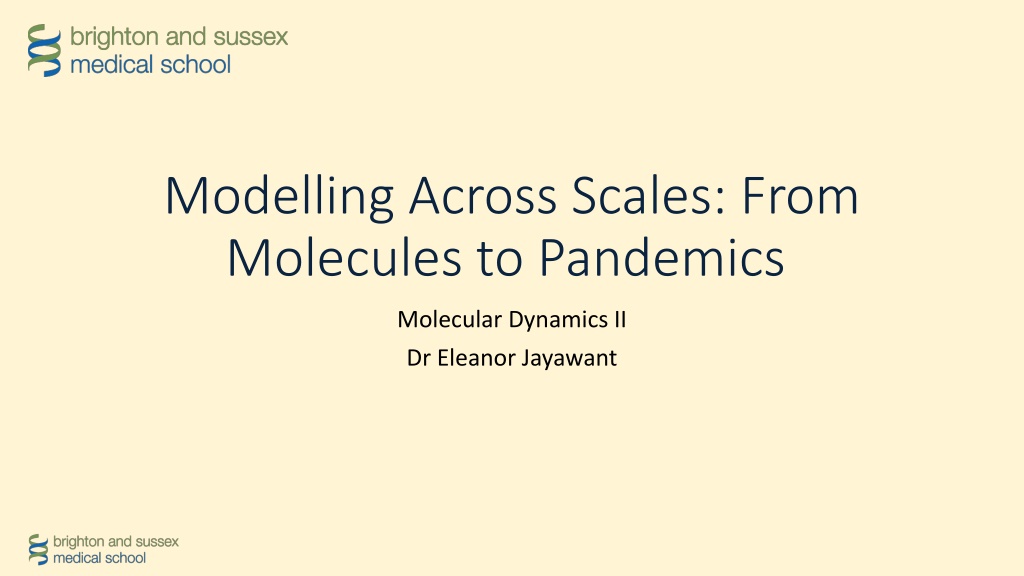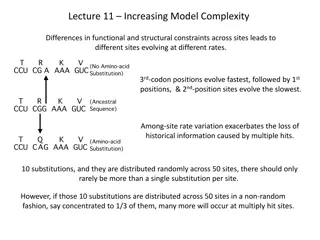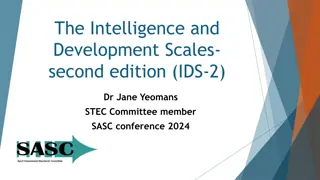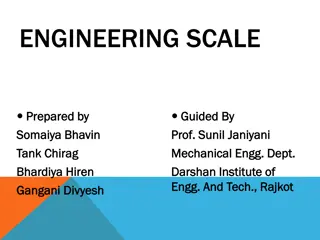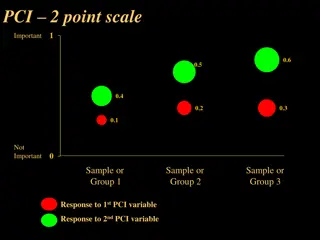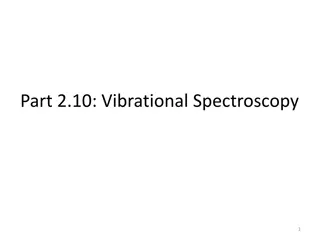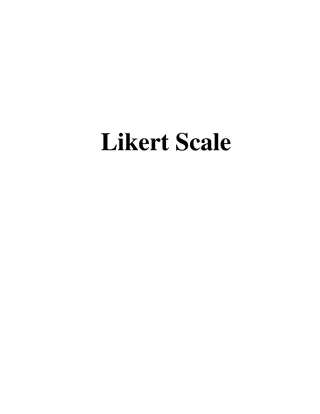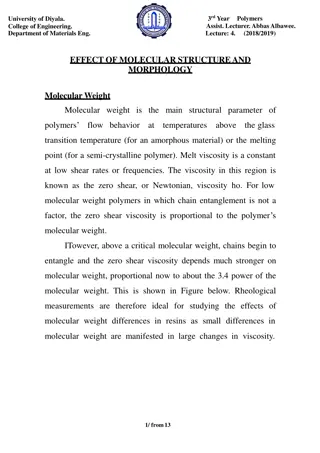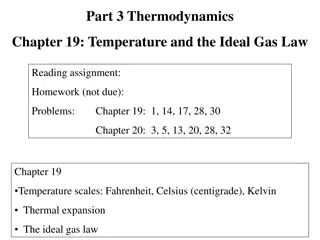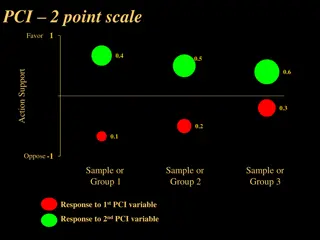Understanding Molecular Dynamics: Insights from Across Scales
Exploring molecular dynamics from molecules to pandemics, this presentation delves into the intricate energy landscapes of molecular systems, sampling problems, advanced techniques, and analysis of simulations to uncover valuable insights crucial for various scientific disciplines like drug discovery and protein studies.
Download Presentation

Please find below an Image/Link to download the presentation.
The content on the website is provided AS IS for your information and personal use only. It may not be sold, licensed, or shared on other websites without obtaining consent from the author. Download presentation by click this link. If you encounter any issues during the download, it is possible that the publisher has removed the file from their server.
E N D
Presentation Transcript
Modelling Across Scales: From Molecules to Pandemics Molecular Dynamics II Dr Eleanor Jayawant
Previously on 104 SSC Molecular dynamics can help us understand how molecules move and interact with each other This is very important for drug discovery MD involves solving Newton s equations of motion iteratively for a system, using a set of interaction potentials called a force field Force fields have a bonded and a non-bonded component Running an MD simulation produces a trajectory of how the atoms move, which can be visualised as a movie Most MD simulations start with a .pdb file, which we looked at for the activity
Energy landscapes are complicated! J, Clayden (2003). Organic chemistry (2nd ed.). Oxford. p. 373.
Energy landscapes are complicated! even though this state has lower energy we might get trapped in this state Energy Conformational State This is called the sampling problem
Advanced sampling techniques can help! Lazim, R., Suh, D. and Choi, S., 2020. Advances in molecular dynamics simulations and enhanced sampling methods for the study of protein systems. International journal of molecular sciences, 21(17), p.6339.
Analysis of MD simulations MD simulations can give us lots of information, including: Secondary structure estimation Hydrogen bonding Angles and dihedrals Root mean squared deviation (how the structure changes over time) Distances between atoms/motifs Solvent accessible surface area Radius of gyration Potential energies Estimates of parameters for experimental techniques (e.g. NMR) And more!
Analysis of MD simulations: secondary structure Secondary structure is very important for overall protein structure and stability Different types of structures are associated with different functions, e.g. alpha-helices are often found in membrane proteins and have important biological functions such as cell signalling initiator We can predict secondary structure for each amino acid in a simulation, using algorithms such as DSSP (Define Secondary Structure of Proteins) This allows us to easily identify regions of secondary structure, and see how it changes over the course of the simulation
Analysis of MD simulations: hydrogen bonding Hydrogen bonds form between a hydrogen atom (donor) bound to a more electronegative atom, and another electronegative atom (acceptor) They play an important role in determining the three-dimensional structures and properties of proteins, and are important for stability between subunits in proteins If we can understand the hydrogen bonding pattern of a macromolecule, we can better understand its structure, properties and function
Analysis of MD simulations: hydrogen bonding Hydrogen bonds form between a hydrogen atom (donor) bound to a more electronegative atom, and another electronegative atom (acceptor) They play an important role in determining the three-dimensional structures and properties of proteins, and are important for stability between subunits in proteins If we can understand the hydrogen bonding pattern of a macromolecule, we can better understand its structure, properties and function Jayawant, E.S., Beadle, J.D., Wilkening, I., Raubo, P., Shipman, M., Notman, R. and Dixon, A.M., 2020. Impact of oxetane incorporation on the structure and stability of alpha-helical peptides. Physical Chemistry Chemical Physics, 22(43), pp.25075-25083.
Analysis of MD simulations: angles and dihedrals Understanding how the angles and dihedrals inside a molecule change over time gives an indication of how the molecule is moving dynamically and which areas might be more flexible/rigid This can also give an indication of secondary structure if we plot the phi vs. psi angles for each amino acid, we can produce a Ramachandran plot Different secondary structure motifs have different characteristic phi/psi angles, corresponding to different regions on the plot We ll make a Ramachandran plot in the activity! https://www.mayoclinic.org/diseases-conditions/creutzfeldt-jakob-disease/multimedia/normal-and-diseased-prions/img-20007478
Analysis of MD simulations: angles and dihedrals Jayawant, E.S., Beadle, J.D., Wilkening, I., Raubo, P., Shipman, M., Notman, R. and Dixon, A.M., 2020. Impact of oxetane incorporation on the structure and stability of alpha-helical peptides. Physical Chemistry Chemical Physics, 22(43), pp.25075-25083.
Analysis of MD simulations: RMSD RMSD is a measure of difference between two structures This is used as an indicator of accuracy of a model, and to ensure that a system is in equilibrium (i.e. not changing still) The smaller the deviation, the more spatially equivalent the two structures More flexible regions of proteins may have large deviations in RMSD, while more stable structures will change less the overall RMSD will be an average of all residues 0.154 nm Arnittali, M., Rissanou, A.N. and Harmandaris, V., 2019. Structure of biomolecules through molecular dynamics simulations. Procedia Computer Science, 156, pp.69-78.
Activity Task: - Open Jupyter Notebook (http://mitchell.science/ssc) - Click Run for each cell to: - Load a PDB file - Run a basic MD simulation - Perform some analysis - You do not need to write any code! - Questions to answer: - What happens to end-to-end distance? - Are there any important structures that emerge in the Ramachandran plot? - What happens if you change the temperature of the simulation? This can be a thought experiment if you don t have time to actually run this simulation! - Last 15 mins class discussion and briefing about assessment
What we covered Dr Eleanor Jayawant. Dr Richard Norris. Arran Pack. Dr Simon Mitchell. Scale: Molecular Dynamics Signalling/Cancer Populations
Learning Outcomes Understand how computers and mathematics are used to simulate biology and how that is useful for medicine. Be able to run models of biological systems across a number of scales. Be able to present results generated from simulations, and understand the insight generated along with the limitations of modelling.
Assessment - 7-minute presentations - present one modelling result. - Using one of the techniques we ve shown you. - Potential slides: - A little background on the biology - What you did (method) - A result graph (or two) and how you interpret it - Some discussion of limitations of the approach - What you could do next. - Answer a question or two!
Assessment - 7-minute presentations - present one modelling result. - Using one of the techniques we ve shown you. - Potential slides: - A little background on the biology - What you did (method) - A result graph (or two) and how you interpret it - Some discussion of limitations of the approach - What you could do next. - Answer a question or two! - Everyone attends weeks 7 and 8 ( and asks questions): - Week 7 presentations: Hin Yip, Lealahni Woulfe, Molly Oakley, Anudi Dharmarathn, Shaiat Uddin, Benedic Phillip - Week 8 presentations: Hannah Wright, Susannah Snowdon, Fahad Saif, Alicja Imrak, Megan Crossman, Agisha Ampikaibalan
Example assessment task 1 Population Scale Run the SEIR (Susceptible, Exposed, Infected, Recovered) population model. http://139.184.170.218:9001 Create a graph with the default parameters (shift enter through entire sheet). Alter a parameter or two Create a new graph with the new parameters, and describe the difference. Relate the parameter change to public health measures or new viral strains.
Example assessment task 2 Cancer modelling Run the Cell Cycle Model http://139.184.170.218:9001 Create a graph with the default parameters (shift enter through entire sheet). Alter a parameter to simulate a mutation. Create a new graph with the new parameters, and describe the difference. Relate the parameter change to mutations and what the change in cell cycle might mean for cancer.
Example assessment task 3 MD Run the MD simulation of polyalanine or polyglycine (or I ve made some extra bonus PDB files with some of your names as the amino acid sequences) http://mitchell.science/ssc Create a Ramachandran plot with the default parameters (shift enter through entire sheet) Investigate what happens if you a parameter e.g.: The length of the simulation The temperature Create a new plot with the new parameters, and describe the difference Are these results what you expected? Why/why not?
